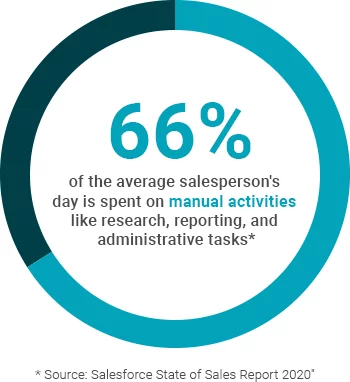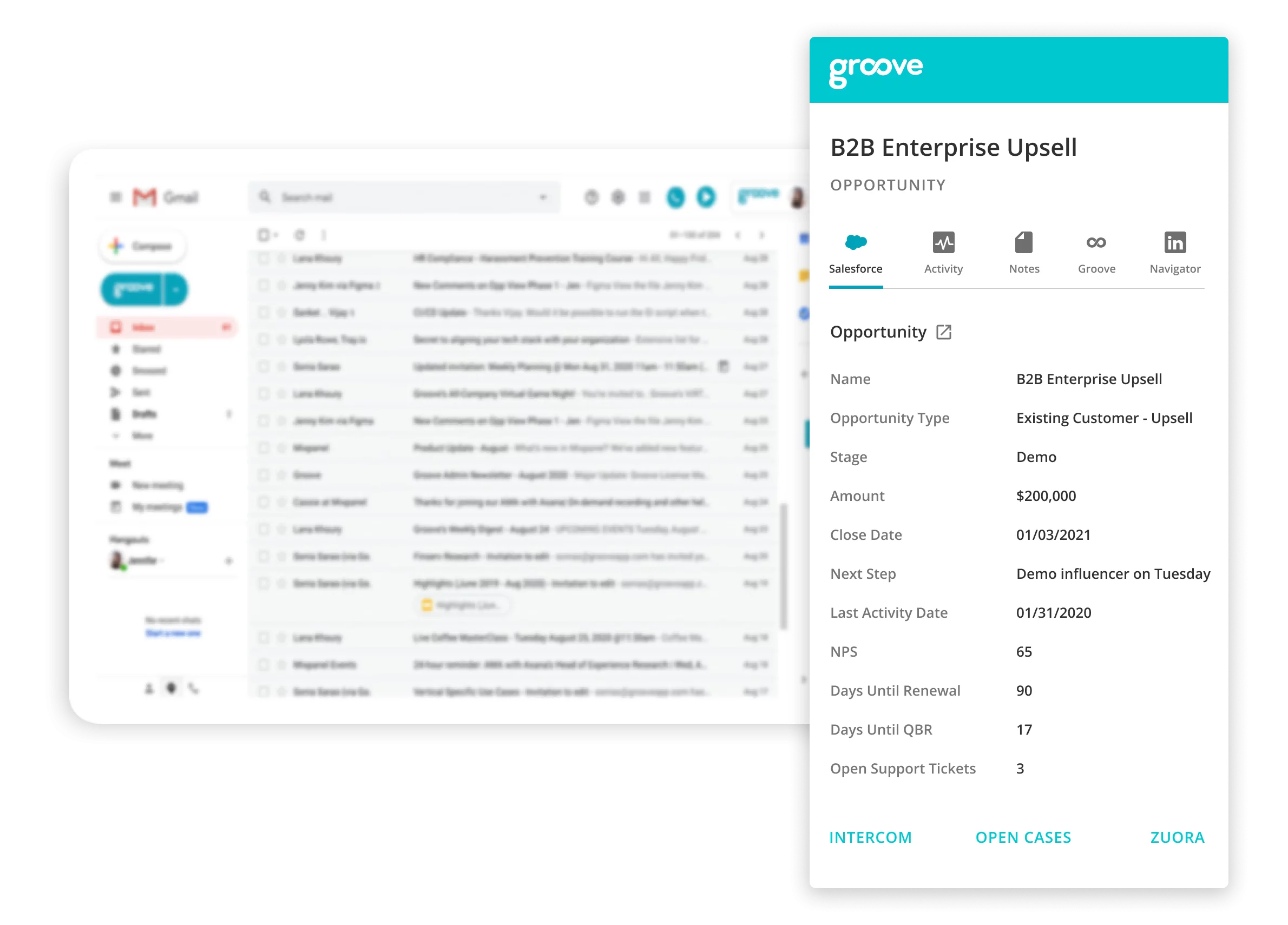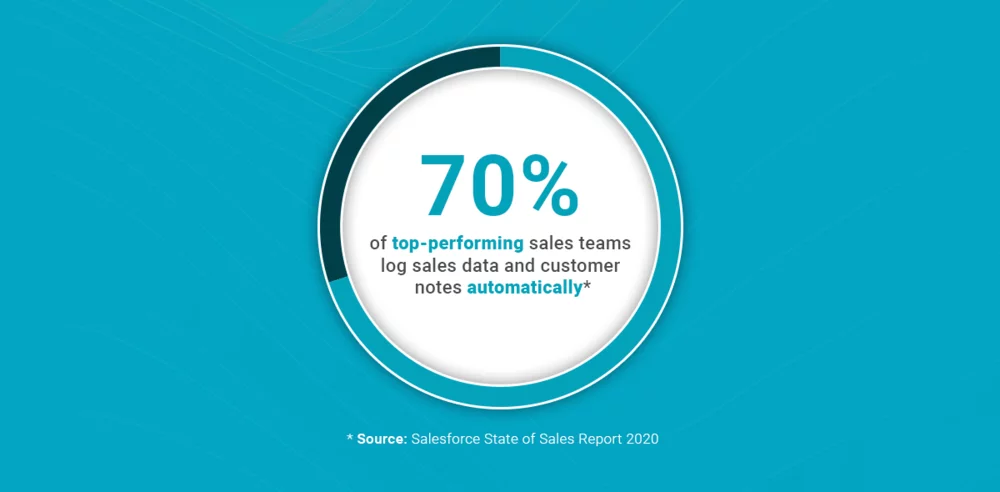"Productivity is being able to do things that you were never able to do before."
Franz Kafka
Increasing sales productivity is not a new concept for teams. Many B2B sales leaders believe that team productivity is tied to winning deals and accelerating revenue. Yet the fact remains that the average salesperson spends 33% of their day selling and the rest on mundane yet necessary activities like research, reporting, and administrative tasks. Today's leaders and teams are in search of ways to work smarter and increase sales productivity by giving reps time back to sell. They're simplifying their systems and processes in order to position their sales teams to be highly productive in a changing selling environment.

Here are 6 sales productivity tips that B2B sales leaders can leverage in order to position their teams to be highly efficient and drive revenue.
1. Get your sales technology stack up to speed
COVID-19 has forced companies to accelerate digital transformation across the board. 77% of sales leaders say their digital transformation has accelerated since 2019 according to Salesforce's State of Sales 2020 report. It may seem like added complexity at first, but greater utilization of technology actually allows teams to simplify data capture, increase productivity, and scale sales engagements in a way not previously possible. The key is implementing agile technologies that make your reps' lives easier, not more complex. If you haven't already done so, look for tools that are best suited for the new realities of your ever-changing selling environment. Now more than ever, it's critical for sales teams to leverage tools that help them build and foster relationships online. At the end of the day, sales technology should work for your team, not against it. If certain tools are adding complexity to your B2B sales process, it's time to consolidate, optimize, or replace.
2. Simplify disparate systems
Next, assess opportunities to fill the gaps in the sales process. Which activities take the most time out of a rep's day? Is searching for Salesforce data costing more time than it's saving? Look for opportunities for your existing technologies to work better together.

When it comes to systems and channels, find out where your reps spend most of their time. Do they work from the email inbox or directly out of Salesforce? It doesn't make sense to invest time and resources into solutions that reps won't use, so orient the sales process around the digital environments and workflows that make your reps comfortable and productive. Implementing technologies that are native to Salesforce can often help managers better customize the user experience and unlock efficiency gains that they hadn't realized.
And lastly, don't forget to examine how your team is capturing, tracking, and reporting data in Salesforce. More sales reps and teams are seeing the value of consistently capturing data—whether that be contact history, opportunity stage, or other custom fields—so that reps and managers can confidently leverage it later.
3. Automate the small stuff
Teams might think that increasing rep efficiency during manual activities is the secret to a highly productive sales team. What many actually find is that their reps operate at max sales productivity (or close to it), and that gains within tasks like prospecting, activity logging, and importing leads have a minimal impact on the overall productivity of the team. However, what does move the needle is using automation to remove those manual, time-consuming tasks altogether.
Start with the small stuff. Research shows that the average salesperson spends two-thirds of their week doing manual tasks like logging activities, importing leads, and updating stages in Salesforce. Automating away these small tasks returns significant time to reps that they can use to focus on high-value activities. It makes sense that nearly 70% of top-performing sales teams log sales data and customer notes automatically, which gives reps more time to focus on selling.
4. Then automate more
Today, prospects don't just spend time in one place—they're in their inbox, checking their phone, and browsing Linkedin, at least. Advanced automation helps sales teams increase speed-to-lead and deliver relevant messaging to prospects wherever they are.
Bringing automation into the email inbox is an easy first step. Set up auto-responders to follow up on new leads from request a demo or contact us forms. Make the first contact immediate for fast speed-to-lead—with no extra effort on the rep's part. Reps can also automate meeting scheduling, giving contacts the opportunity to find the meeting time that works best for them instead of going back and forth.
Go a step further and create advanced flows that trigger automatically based on unique criteria. Prospects receive sequenced touches across multiple channels and reps don't even have to hit "send." The potential for automation is huge for revenue teams looking to increase productivity.
5. Create a personalization process that scales
The data on personalization is in, and the story is clear: personalized communication significantly increases engagement. Emails with personalized subject lines get 26% more opens, and 74% of online consumers get frustrated when content (e.g. offers, ads, and promotions) appear to have nothing to do with their interests. Online consumers are also B2B buyers. More than half (55%) of B2B sales and marketing professionals in 2020 say that marketing personalization leads to higher rates of sales conversions and future growth.

So sales reps should personalize their messages—easy enough, right? Not so fast! Quite literally: conducting research is slow. These days, a variable {first.name} tag isn’t enough to cut through the noise and reps can spend all day researching and crafting personalized messages for each prospect. What's more, reps often waste time switching back and forth between their inbox, CRM system, and Linkedin while researching a prospect. That doesn't scale.
The most productive sales teams turn personalization into a process by integrating systems that allow reps to conduct research quickly and easily weave relevant data into an effective message. Look for opportunities to streamline the research stage by surfacing Salesforce, LinkedIn, and sales intelligence data to reps in real-time so they don't have to spend their time searching for it. Create and share email templates and phone scripts across the team to increase the speed and consistency of your team's messaging.
Lingotek was able to create a process for sending out a high volume of personalized emails per day. "Our AEs can send out 150 very targeted and relevant emails in a day—and they don't have to log into their computer to do it," said Greg Larsen, VP of revenue operations at Lingotek. "Sales leaders can set up the Flows, get the messaging right, and if the AE wants to break into a company, they just drop a few contacts into Flows that have already been tested, and before long they're seeing results." This process allowed Linkgotek's team to double the amount of meetings set using the same number of SDRs.
6. Make space to collaborate virtually
Not only have touchpoints with buyers migrated online, internal communication within revenue teams has also changed drastically. Goodbye, team stand-ups and white board sessions. Hello, Zoom rooms and shared workflows. As natural opportunities for inter-team communication become less frequent, it's even more important for revenue teams to align around high-value accounts and contacts so that no lead slips through the cracks.
Teams with the highest productivity leverage collaborative online spaces where team members can check in and see the team's focus for the day, month, and quarter. Invite other teams in the revenue organization to contribute to these collaborative spaces. The more visibility teams have into accounts, the more coordinated each team can be in their engagement. This is also a great place to share successful email templates and call scripts so reps can use what’s working instead of spending time reinventing the wheel.
Revenue leaders know that aligning teams around shared goals is critical for breaking into big accounts and accelerating revenue. In fact, 77% of salespeople say that selling collaboratively with other departments is important. Providing reps and account managers with cross-vision into the different teams and groups selling into their accounts gives them the context they need to engage with confidence.
Key takeaways
- Evaluate the tools your reps already have and look for gaps
- Find out where reps spend most of their time and optimize
- Eliminate manual activity logging so reps can focus on high-value activities
- Streamline your team's research process so reps can personalize their messages at scale
- Create shared workspaces where teams can collaborate on top accounts and share successful strategies
If your company uses Salesforce and you are interested in learning more about how Groove can provide your team with tools needed to boost sales productivity for your revenue teams, request a demo of our sales engagement platform today.



